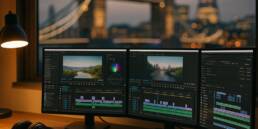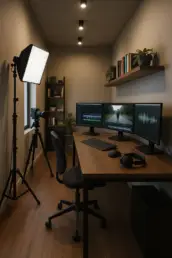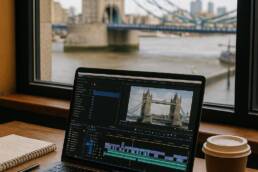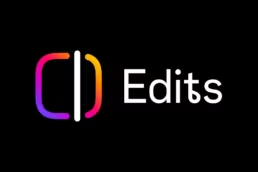
Being a freelance video editor in London is a bit like juggling hard drives while balancing on a Boris bike. No two days are the same. That’s part of the fun, and also part of the chaos. Here’s a peek into three typical-but-not-so-typical days in my freelance life. A true day in the life of a freelance video editor in London, with all the tech hiccups, tea breaks and timeline drama included, or if you want some top tips for hiring a video editor in London
Table of Contents
ToggleDay 1: On Location. In a Basement Next to the Action
There’s a strange calm before the storm. While the crew is lugging gear, chasing natural light and arguing with tripods, I’m usually hidden in a portacabin or a converted basement with dodgy Wi-Fi and a kettle that’s seen better days.
The Setup
The brief is always the same: “Just plug in and be ready to cut a teaser in case the commissioner wants something before wrap.”
What that really means is nothing will happen for hours, then everything needs to happen right now.
Just as I’m deep into a delicate render, someone unplugs my power supply to charge a drone.
-
Client Expectation: “It’s just a quick edit.”
-
Reality: Half the footage is missing audio, and the best take was on a GoPro someone forgot to press record on.
-
Peak Chaos Moment: When everyone packs up and leaves. I’m the only one left. In the dark. With my laptop still exporting.
-
Bonus Feedback I’ve Received: “Can we move pre-production until after delivery?”
It’s just another day in the life of a freelance video editor in London, where the timeline waits for no one and you’re always one step away from a power cut.


Day 2: In a Client’s Office. Hello, 9 to 5
This is the closest I get to a “normal” job. I cycle in or take the Tube, then shuffle into a lift where someone inevitably says, “Oh, you’re an editor? My nephew does YouTube.”
The Setup
I’m at a desk with one borrowed monitor, a keyboard missing a working shift key and the strong smell of someone else’s lunch. But hey, there’s a coffee machine and I go out for lunch like a proper grown-up.
I do meetings. I experience printer rage. The first time the team sees their cut, it’s like watching their own Hollywood premiere. Meanwhile, I’m silently praying they don’t ask for a different music track again.
Corporate Requests I’ve Actually Heard:
-
“Can it be shorter but say more?”
-
“Let’s just remove the talking bits but keep the message.”
-
“We’d like to see more diversity. Can we Photoshop that in?”
-
Client Expectation: “It’s all final. No changes.”
-
Reality: “Just a few tweaks…” followed by 47 Vimeo comments with timecodes.
-
Pro Tip: Make friends with IT on day one. You’ll need them when downloading a terabyte over a shaky FTP that crashes at 98 percent.
If you ever wondered what a day in the life of a freelance video editor in London really looks like, it’s somewhere between creative problem-solving and hunting for a working USB port in a glass-walled office.
Day 3: Working From Home. Comfy and Focused
No distractions. No commuting. No drone chargers. Just me, my rig and my tea.
The Setup
Triple monitors. Good lighting. An ergonomic chair that cost more than my first car. With no commute, I’m straight into the timeline and often forget to eat. That’s where tea comes in.
Tea isn’t just cultural. It’s how I stay hydrated, take toilet breaks and solve creative problems.
The Routine
Tea. Timeline. Toilet. Repeat. Five minutes away every hour can reset your brain, especially when you’re watching the kettle boil for the 30th time today.
-
Peak Freelance Energy: Looking up at 8.45pm and realising I’ve just spent an hour colour grading a shot that lasts three seconds.
-
Working Abroad Flashback: We once ran out of tea on a shoot in remote Mexico. It was 37°C. The kettle broke. The runner drove 10 miles to Walmart for a replacement. We only had UK plugs. The struggle was real.
And yet, it still felt like a regular day in the life of a freelance video editor in London. Just one with a very confused kettle.


Glossary for the Curious
-
Fix it in post: The magical belief that editing can solve everything from bad acting to no coverage.
-
Timecode: A timestamp format used to identify specific frames. Essential when your client says, “Change that bit around 02:34.”
-
Rendering: When your computer turns your timeline into a finished file. Also when it crashes at 99 percent for no reason.
Client Expectations vs Reality
| Expectation | Reality |
|---|---|
| “It’s just a 30-second video.” | Footage is 8 hours long, shot on five cameras. |
| “We’ll sign off quickly.” | Seven rounds of amends, then the boss chimes in. |
| “No changes, promise.” | Friday night email. “Just one more version.” |
| “Use our brand guidelines.” | Brand guidelines last updated in 2015. |
| “It’s plug and play.” | Missing fonts, weird codecs, corrupt files. |
| “It’s just a social clip.” | Legal needs to sign off every frame. |
| “We’ll provide assets.” | Assets arrive after the deadline. |
| “It’s all been filmed properly.” | Fix it in post. |
Final Thoughts from the Edit Cave
Freelance editing is unpredictable, creative, frustrating and often hilarious. One day you’re in a broom cupboard with 3 percent battery. The next, you’re in a boardroom being told someone in HR’s daughter is “into video stuff.”
But we adapt. We make it work. We fix it in post. And we always carry a spare plug.
Freelance Mantra: Adapt or die. Always keep a spare charger.
Whatever your setup, editing from a shoebox-sized Soho suite or working barefoot from your kitchen table, it’s all part of a very real day in the life of a freelance video editor in London services.
Free Download: What to Pack for On-Location Edits
Download this handy checklist so you’re never caught without a plug adapter or spare drive again.
Joe Savitch-Lee
Over 20 years in media, having worked on four continents and on countless projects both on location and in a suite. He has excelled in both building/maintaining editing systems and editing them.




